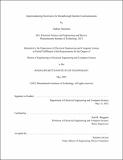Superconducting Electronics for Breakthrough Starshot Communications
Author(s)
Sorenson, Andrew
DownloadThesis PDF (7.342Mb)
Advisor
Berggren, Karl K.
Terms of use
Metadata
Show full item recordAbstract
Gram-scale sailcraft for the Breakthrough Starshot project are currently being designed to travel to Proxima Centauri, 4.24 light years away, and transmit back images and data [1]. In order to meet the size, weight, and power constraints of the mission, superconducting electronics should be considered for onboard processing and interfacing with the communications system. Previous research has shown that superconducting nanowire electronics consume over 100𝗑 less switching energy than 7 nm CMOS electronics [2]. In order to pursue application of superconducting electronics on Starshot probes, fundamental questions must be answered regarding the suitability of superconducting materials in the interstellar environment. To investigate this suitability, we performed numerical analysis of the effects of both radiation and temperature on superconducting electronics. We also designed, simulated, and tested superconducting nanowire devices tailored to Starshot operations. We found that with an edge-on sail transit configuration, equilibrium temperature of the sail may be below the critical temperature of common superconductors and that the anticipated error rate from radiation is 1. 23 𝗑 10⁻¹⁸ µ𝑚⁻² 𝑛𝑠⁻¹ also present the design and simulation of a circuit modification that may drastically reduce the error rate in exposed superconducting nanowires. By finding that there are no immediate show-stoppers for using superconducting electronics onboard, we hope to inspire future investigations into the use of superconducting nanowire electronics for Starshot and other deep space missions.
Date issued
2022-05Department
Massachusetts Institute of Technology. Department of Electrical Engineering and Computer SciencePublisher
Massachusetts Institute of Technology